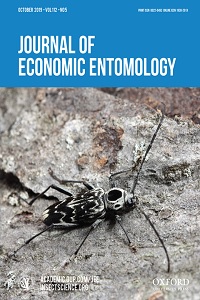Antibiosis to Spittlebugs (Homoptera: Cercopidae) in Accessions of Brachiaria spp.
High levels of antibiotic resistance to the cercopid Aeneolamia varia (F.) were identified in accessions of the forage grass Brachiaria by means of a glasshouse bioassay. Emergence of adults from pots of Brachiaria spp. infested with eggs of A. varia ranged from 55 to 83% and 56 to 80% on susceptible B. decumbens Stapf cv. Basilisk and B. dictyoneura (Fig. & De Not.) Stapf cv. Llanero, respectively, compared with 3–33% on the resistant B. brizantha (A. Rich.) Stapf cv. Marandu. Eleven accessions from six species of Brachiaria were identified as being at least as resistant as ‘Marandu’ based on adult emergence. Two accessions of B. jubata (Fig. & De Not.) Stapf (CIAT 16531 and CIAT 16203) were highly antibiotic. When reared on B. jubata CIAT 16531, nymphs that survived until the fourth or fifth instar subsequently died during molt after apolysis was initiated but before ecdysis could be completed, and were malformed. All nymphs that died during final molt were in the pharate condition before ecdysis began or were unable to complete ecdysis. Survival of nymphs beyond the third instar on B. jubata CIAT 16203 was very low. When late instars were transferred from ‘Basilisk’ to B. jubata CIAT 16203, survival was reduced compared with nymphs transferred to ‘Llanero’, and deformations and molt disruption were observed. Molt disruption is postulated to be the mechanism of resistance in B. jubata CIAT 16531 and 16203. Adult females produced less excreta when caged on the resistant accessions B. jubata CIAT 16531 and ‘Marandu’ compared with the susceptible ‘Basilisk’ and ‘Llanero’.

